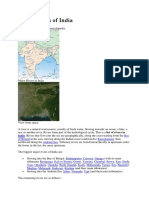(Environment) Landslides in Himalayas: Reasons, Solutions: Method #1
(Environment) Landslides in Himalayas: Reasons, Solutions: Method #1
Uploaded by
Arvind PaulCopyright:
Available Formats
(Environment) Landslides in Himalayas: Reasons, Solutions: Method #1
(Environment) Landslides in Himalayas: Reasons, Solutions: Method #1
Uploaded by
Arvind PaulOriginal Description:
Original Title
Copyright
Available Formats
Share this document
Did you find this document useful?
Is this content inappropriate?
Copyright:
Available Formats
(Environment) Landslides in Himalayas: Reasons, Solutions: Method #1
(Environment) Landslides in Himalayas: Reasons, Solutions: Method #1
Uploaded by
Arvind PaulCopyright:
Available Formats
[Environment] Landslides in Himalayas: Reasons, Solutions
* * * * * * * * * *
Three main geological divisions of India. Classification of Himalayas Hazards in the Himalayan Eco-System Regions and disasters Landslides: Reasons Landslides: Damage Suggestions to fix problem
Three main geological divisions of India. Himalayas, also known as the Extra-Peninsula Indo-Gangetic Plains Peninsula
Classification of Himalayas Method #1
* * * * *
Himalayas are classified, from west to east, into four regions: Punjab Himalaya area between Indus and Sutlej rivers. Kumaon Himalaya area between Sutlej and Kali rivers Nepal Himalaya- area between Kali and Tista rivers. Assam Himalaya- area between Tista and Brahamputra rivers.
Method#2
* *
three regions: the Western, Central and Eastern Himalaya Nepal Himalaya constitutes the Central Himalaya and the mountainous area to its west and east are known as Western and Eastern Himalaya respectively
Hazards in the Himalayan Eco-System
* * *
All major types of disasters, prominently earthquakes, landslides,
* * * *
avalanches, flash floods forest fires soil erosion
Regions and disasters Altitude Over 3500m 500 to 3500 m Landslides: Reasons Type of disaster snow avalanches and glacial lake outburst floods (GLOFs) flash floods; landslides and mudflows
* * * *
indiscriminate chopping down of trees. slash and burn cultivation technique called JHUM, Road construction and mining. Every increasing population, grazing, urbanization etc. has destroyed the dense natural evergreen forest cover.
Such activities have disrupted the ecological balance, thereby resulting in loosening of the soil. During the heavy rain, this leads to soil erosion and frequent landslides Landslides: Damage
* * * * * * *
Every year, landslides in the region kill dozens of people and cause widespread damage to several villages such that they have now become almost unfit for habitation. They create blockades in the road network and river system, which in turn, cause floods. The terraced farm fields have been destroyed that cannot be easily renovated or made productive again. The road network remains closed for long periods causing indescribable hardship to the villagers who get their basic supplies and provisions from the neighbouring areas. Water source is also disrupted due to landslides as they are breached from several places and are choked by the debris. The sediment load of rivers has also increased considerably, causing problems like irregular courses and frequent breaching of the banks, which create uncertainty regarding the river course and unexpected floods. The water channels are affected from the up hillside due to which the villagers are devoid of water for irrigation purposes. This adversely affects agriculture production in the region.
Suggestions to fix problem
* *
Excess water should be stored in the catchments areas, which will reduce the fury of flash floods, recharge the ground water and improve the environment. Runoff collection ponds in the catchments, though they might get silted up in a few years, will be more useful than the measures in the lower reaches.
* * * * * *
To prevent rapid siltation of tanks, the contributing catchments (even if they are not cultivated but used for grazing or forestry purposes) need to be well managed so that soil erosion is prevented. All common lands should be put under fuel/fodder trees. Planting of barren areas, especially on slopes, with grass cover is an important component of integrated watershed management programme. Grazing should be completely restricted. After the area is completely protected from grazing, better grasses can be planted. The grasses of industrial importance should also be planted so that there is some economic return to the farmers as well. The surface vegetative cover will not only protect the land from the beating action of rain drops and bind the soil particles but would also decrease the velocity of flowing water and cause less of soil erosion .
[Biodiversity] National Aqatic Animal This is shared by Varoon Bakshi.
* * * * * * * * *
The River Dolphin is found in the River Ganges. In 2009, The Ganga River Dolphin was declared the National Aquatic Animal of India by the National Ganga River Basin Authority which is chaired by the Prime Minister. The Ganga River Dolphin is basically found in the Ganga and Brahmaputra river systems. Around 1500-2000 River Dolphins are found in the aforementioned two river systems. The scientific name of the Ganga River Dolphin is Platanista Gangetica.
Problems faced by River Dolphins The habitats of the Ganga River Dolphins are shrinking as smaller rivers are drying up and bigger rivers do not have uninterrupted flow of water in various parts. Thus the Ganga River Dolphins are perhaps one of the few creatures which face extinction due to the destruction of their habitat instead of being hunted or poached. Although, these river dolphins are hunted for their oil and sometimes they get stuck in the nets of the fishermen and die. By declaring the Ganga River Dolphin as the National Aquatic Animal of India there will be some focus on the plight of these animals.
[EnB] National Seabuckthorn Initiative
What is Seabuckthorn?
* * * * * * * * *
What are the uses of Seabuckthron? What is National Seabuckthorn Initiative? What will they do? CSAT 2012 Actual Question Mock Questions for GS Mains (Paper I) Previous Articles under EnB
What is Seabuckthorn? Seabuckthorn (Leh berry) is a shrub It grows in the dry temperate and cold desert of the Himalayas. Found extensively in Jammu & Kashmir, Himachal Pradesh, Uttatrakhand, Sikkim and Arunachal Pradesh.
What are the uses of Seabuckthron?
Has multi-purpose medicinal and nutritional properties, besides being useful for soil conservation and nitrogen fixation. Since this is the only plant that can grow in high altitude regions it can be easily used for water and soil conservation. Can aid in climate change mitigation and provide livelihoods support thereby reducing pressures on the ecosystem.
* Ideal plant for desertification control.
Every part of the plant viz. Fruit, leaf, twig, root and thorn has been traditionally used as medicine, nutritional supplement, fuel and fence, and therefore, seabuckthorn is popularly known as
* * * *
Wonder Plant, Ladakh Gold, Golden Bush or Gold Mine.
What is National Seabuckthorn Initiative?
* * * * *
Indias National Action Plan on Climate Change It has a key Mission called Green India Mission Under this Green India Mission, there is a Sub-Mission on Cold Desert Ecosystems This Sub-Mission will include the National Seabuckthorn Initiative. In 2010, Ministry of Environment & Forests (MoEF) and the Defense Research and Development Organisation (DRDO) have jointly launched a major new national initiative for seabuckthorn cultivation in the high altitude, cold desert ecosystems of the country.
What will they do?
* *
Under this initiative, Eco Task Force Battalions and Womens Self-help groups will be mobilised for plantation of seabuckthorn in remote areas. Research and Development (R&D) for cultivation and commercial processing in collaboration with China, Russia, Pakistan, Germany etc nations where this plant is found.
You might also like
- Chapter 1 The Land of Pakistan (Topography)Document26 pagesChapter 1 The Land of Pakistan (Topography)Abdullah Abbas88% (8)
- Table Tennis - Score SheetDocument1 pageTable Tennis - Score SheetArvind Paul75% (4)
- Highest Mountains in The World PDFDocument4 pagesHighest Mountains in The World PDFGARIMA VISHNOINo ratings yet
- 06 - Chapter 2-3Document34 pages06 - Chapter 2-3John KAlespiNo ratings yet
- Hazards in The Himalayan Eco-SystemDocument4 pagesHazards in The Himalayan Eco-SystemSurender SuriNo ratings yet
- GIAHS Sites in India: Koraput, Odisha State: ProblemsDocument8 pagesGIAHS Sites in India: Koraput, Odisha State: ProblemsArvind PaulNo ratings yet
- EVS Prev Year Q & A MODULE 1Document15 pagesEVS Prev Year Q & A MODULE 1Abhijith NairNo ratings yet
- Landslides in Himalayas: Reasons, Solutions: Three Main Geological Divisions of IndiaDocument4 pagesLandslides in Himalayas: Reasons, Solutions: Three Main Geological Divisions of Indiavivek559No ratings yet
- Unit I Natural ResourcesDocument18 pagesUnit I Natural Resourcesaimmmneet2024No ratings yet
- Wetlands of AssamDocument7 pagesWetlands of AssamHasibuddin AhmedNo ratings yet
- EVS UNIT 2 NotesDocument21 pagesEVS UNIT 2 NotesNivashini VindhyaNo ratings yet
- Forest Resources Use and Over-Exploitation, DeforestationDocument5 pagesForest Resources Use and Over-Exploitation, DeforestationAnurag100% (2)
- Republished: Do You Know?Document13 pagesRepublished: Do You Know?Alisha ChopraNo ratings yet
- Natural Resources: Prepared By, Mr. Snehal Patel Assistant Professor, Sumandeep Vidyapeeth, Vadodara, Gujarat, IndiaDocument52 pagesNatural Resources: Prepared By, Mr. Snehal Patel Assistant Professor, Sumandeep Vidyapeeth, Vadodara, Gujarat, IndiaJagesh RanjanNo ratings yet
- Water Resources - Shobhit NirwanDocument4 pagesWater Resources - Shobhit Nirwan38 [X 'HD'] PRAKRIT KUMAR100% (7)
- Water Resources - Shobhit NirwanDocument4 pagesWater Resources - Shobhit Nirwanxejis32065No ratings yet
- Dal Lake: Issues and Management StrategiesDocument5 pagesDal Lake: Issues and Management StrategiesImtiyaz KhanNo ratings yet
- Natural Resources: Unit - 2Document51 pagesNatural Resources: Unit - 2Sharmila BalanNo ratings yet
- Natural ReNatural Resources and Associated Problemssources and Associated ProblemsDocument24 pagesNatural ReNatural Resources and Associated Problemssources and Associated ProblemsAnkur PoddarNo ratings yet
- Unit 3, Natural Resources Lec 2Document15 pagesUnit 3, Natural Resources Lec 2Arsha TanejaNo ratings yet
- EVS (Unit3)Document6 pagesEVS (Unit3)santoshkumari030276No ratings yet
- Water ResouecesDocument3 pagesWater ResouecesMaria JohncyNo ratings yet
- Case StudiesssssssssDocument44 pagesCase StudiesssssssssRAGHAV AGRAWALNo ratings yet
- Unit 3Document26 pagesUnit 3rajeev.sbilife78No ratings yet
- Mangrove Forest in IndiaDocument12 pagesMangrove Forest in IndiaShabnam DhaliwalNo ratings yet
- WaterDocument3 pagesWaterRenuka VisveswariNo ratings yet
- Environmental Studies & Disaster Management: Course InstructorDocument7 pagesEnvironmental Studies & Disaster Management: Course InstructorImtiyaz KhanNo ratings yet
- Unit 2 - Natural Resources LectureDocument60 pagesUnit 2 - Natural Resources LectureSamrudhi PatilNo ratings yet
- Natural ResourcesDocument10 pagesNatural Resourceslakshmiearthmovers01No ratings yet
- EVS - Unit 1 - Natural ResourceDocument41 pagesEVS - Unit 1 - Natural Resourcer1u2No ratings yet
- Geo Water NotesDocument9 pagesGeo Water Notesbosonvoyagernishith1915No ratings yet
- QAGeographyDocument5 pagesQAGeographymalanupamNo ratings yet
- © Ncert: MulchingDocument12 pages© Ncert: MulchingAlisha ChopraNo ratings yet
- Evs Unit-3Document61 pagesEvs Unit-3Pandiya RajanNo ratings yet
- Republished: LandslidesDocument14 pagesRepublished: LandslidesAlisha ChopraNo ratings yet
- Natural Resource1Document38 pagesNatural Resource1Yogesh KumarNo ratings yet
- RiversDocument43 pagesRiversniginkabrahamNo ratings yet
- Enviornmnet Components and RelationshipDocument23 pagesEnviornmnet Components and Relationshipsehrish iqbalNo ratings yet
- Lecture 10Document36 pagesLecture 10sailorg90No ratings yet
- Watershed Unit-1Document8 pagesWatershed Unit-1GEO1903 Jagadeesh SNo ratings yet
- Unit IiDocument58 pagesUnit IiVeRuNo ratings yet
- Unit 3 Natural ResourcesDocument41 pagesUnit 3 Natural ResourcesRose vNo ratings yet
- On Forest SocietyDocument11 pagesOn Forest Societyvaidika.soni12009No ratings yet
- Natural Resources (Bba)Document66 pagesNatural Resources (Bba)Anu kritiNo ratings yet
- Natural ResourcesDocument18 pagesNatural ResourcesTEJAS .M.S.No ratings yet
- Environmental Issues & ProblemsDocument25 pagesEnvironmental Issues & ProblemsJosephine RodolfoNo ratings yet
- Global Environment Issues and ConcernsDocument25 pagesGlobal Environment Issues and ConcernsCyrose John SalasNo ratings yet
- Conservation of Plants and AnimalsDocument12 pagesConservation of Plants and AnimalsKalai VaniNo ratings yet
- Environment EcologyDocument20 pagesEnvironment EcologyPriya KumariNo ratings yet
- Water ResourcesDocument49 pagesWater ResourcesDelta ForceNo ratings yet
- AEZ in BD (10.02.2021)Document11 pagesAEZ in BD (10.02.2021)Fahrial ImroseNo ratings yet
- Environmental StudiesDocument19 pagesEnvironmental Studiesbookworm6363636No ratings yet
- Sts Prelim m3Document2 pagesSts Prelim m3Jessa Mae BalagaNo ratings yet
- Management of Natural Resources - Question Bank PDFDocument7 pagesManagement of Natural Resources - Question Bank PDFRatheesh Hrishikesh100% (1)
- ST - John's Water ConservationDocument19 pagesST - John's Water ConservationAbhishekShubhamGabrielNo ratings yet
- EVS Unit I NotesDocument14 pagesEVS Unit I NotesMohammed SiddiqNo ratings yet
- Deforestation Is The Permanent Destruction of Indigenous Forests and WoodlandsDocument3 pagesDeforestation Is The Permanent Destruction of Indigenous Forests and WoodlandsTara Idzni AshilaNo ratings yet
- Mity Niversity Harkhand: Subject: Environmental ScienceDocument36 pagesMity Niversity Harkhand: Subject: Environmental ScienceRakeshagentNo ratings yet
- Water ResourcesDocument5 pagesWater ResourcesWilliam PrabhakarNo ratings yet
- Chapter 3Document12 pagesChapter 3preetybedi74No ratings yet
- © Ncert Not To Be Republished: Above PictureDocument16 pages© Ncert Not To Be Republished: Above PictureAlisha ChopraNo ratings yet
- Natural Resources: Panipat Institute of Engineering and TechnologyDocument51 pagesNatural Resources: Panipat Institute of Engineering and TechnologysumankhuranaNo ratings yet
- Lieca - PPTX Final Presentation MST e Subject - 081412Document36 pagesLieca - PPTX Final Presentation MST e Subject - 081412judyannetol25No ratings yet
- Didcot & District Table Tennis Association: Handicap ShieldDocument1 pageDidcot & District Table Tennis Association: Handicap ShieldArvind PaulNo ratings yet
- RKMV Shimla-1 Date Sheet of Annual Practical Examination of Class B.A.-I Under The Choice Based Credit System Subject Date Time PsychologyDocument3 pagesRKMV Shimla-1 Date Sheet of Annual Practical Examination of Class B.A.-I Under The Choice Based Credit System Subject Date Time PsychologyArvind PaulNo ratings yet
- Form No. 16: 9. Rebate and Relief (Section 80C)Document2 pagesForm No. 16: 9. Rebate and Relief (Section 80C)Arvind PaulNo ratings yet
- 3RD Inter College Women PDFDocument3 pages3RD Inter College Women PDFArvind PaulNo ratings yet
- The Journey Since 1997 .: J.L NehruDocument2 pagesThe Journey Since 1997 .: J.L NehruArvind PaulNo ratings yet
- Vote of ThanksDocument2 pagesVote of ThanksArvind PaulNo ratings yet
- Csca Election 2014Document2 pagesCsca Election 2014Arvind PaulNo ratings yet
- THEMESDocument2 pagesTHEMESArvind PaulNo ratings yet
- #2 Clean Development Mechanism (CDM)Document59 pages#2 Clean Development Mechanism (CDM)Arvind PaulNo ratings yet
- What Is SAR?Document16 pagesWhat Is SAR?Arvind PaulNo ratings yet
- Nirmal Rajya: What Is Blue Moon? Why Blue Moon? Why in News? What Is Blue Moon?Document7 pagesNirmal Rajya: What Is Blue Moon? Why Blue Moon? Why in News? What Is Blue Moon?Arvind PaulNo ratings yet
- Itr 2Document9 pagesItr 2Arvind PaulNo ratings yet
- DID Bauxite WMDocument69 pagesDID Bauxite WMGeo Khader Abdul100% (1)
- Form NoDocument4 pagesForm NoArvind PaulNo ratings yet
- Environmental Impacts Hills and MountainsDocument15 pagesEnvironmental Impacts Hills and MountainsAnvesh VakadiNo ratings yet
- Book ListDocument5 pagesBook ListAnupam DasNo ratings yet
- A Case Study of Cavity Formation and Its Rectification Works in Small Sized Tunnel With Excessive Water InflowDocument11 pagesA Case Study of Cavity Formation and Its Rectification Works in Small Sized Tunnel With Excessive Water InflowAsim TimalsinaNo ratings yet
- Physical Featues of India - 9 CBSEDocument3 pagesPhysical Featues of India - 9 CBSEEshan AttarNo ratings yet
- 9th Without MapsDocument52 pages9th Without Mapsstrangers123thingsNo ratings yet
- Ancient History Tamilnadu Board NotesDocument8 pagesAncient History Tamilnadu Board NotessweetyNo ratings yet
- Semester: Book - 3ADocument32 pagesSemester: Book - 3ARajiv PawarNo ratings yet
- Unit 7Document10 pagesUnit 7pareekkaran007No ratings yet
- Static GK Ebook in Eng SampleDocument49 pagesStatic GK Ebook in Eng SampleSarthak ChaudharyNo ratings yet
- BalBooks 5Document92 pagesBalBooks 5SiddhuNo ratings yet
- Geography PPPDocument161 pagesGeography PPPMUHAMAD HUSSAINjunaidNo ratings yet
- Rivers of IndiaDocument37 pagesRivers of IndiaSuhailHaqueNo ratings yet
- Sample Speech OutlineDocument3 pagesSample Speech OutlineRosemarie S. VerolaNo ratings yet
- Climate of South Asia 6th To 8th STDDocument9 pagesClimate of South Asia 6th To 8th STDlafdebazNo ratings yet
- Latihan Mengerjakan Soal 1Document13 pagesLatihan Mengerjakan Soal 1Sonia PertiwiNo ratings yet
- Cbse Class 10 Social Science Geography Chapter 2 NotesDocument10 pagesCbse Class 10 Social Science Geography Chapter 2 Notesrs.aishwarya2709No ratings yet
- Tehri Garhwal PDFDocument25 pagesTehri Garhwal PDFsonal sonalNo ratings yet
- Phytogeography of IndiaDocument44 pagesPhytogeography of IndiaAnupama Praveen100% (1)
- Study Methodology: Impact Area DelineationDocument12 pagesStudy Methodology: Impact Area DelineationSuman LamaNo ratings yet
- Topic:: Explain The Role of Landform, Water System, Climate and Vegetation in Cities of India?Document2 pagesTopic:: Explain The Role of Landform, Water System, Climate and Vegetation in Cities of India?PranavNo ratings yet
- Appropriate Technology of IndiaDocument21 pagesAppropriate Technology of IndiaMohit JamwalNo ratings yet
- Geo Smart Summaries...Document65 pagesGeo Smart Summaries...Waleed Aftab67% (3)
- 4.3 Swot Anaylsis StrengthDocument9 pages4.3 Swot Anaylsis StrengthAMRITNo ratings yet
- Irrigation in UttarakhandDocument36 pagesIrrigation in Uttarakhandjaargavi dendaNo ratings yet
- BiodiversityDocument39 pagesBiodiversitysaloni bhardwajNo ratings yet
- Wbcs Main Special 2 NEW PDFDocument52 pagesWbcs Main Special 2 NEW PDFMili SarkarNo ratings yet
- Feasibility Study Report - Main Report - TeliyaDocument94 pagesFeasibility Study Report - Main Report - Teliyasonusk777100% (1)








































































































